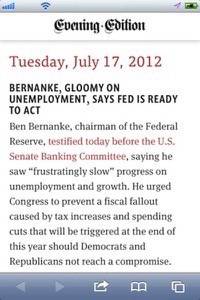
A Web design studio built the first news site I’ve ever read from top to bottom two days in a row, and it did so as a side project. Mule Design is not in the journalism business. It builds sites to solve all manner of client communication problems. But it did in a week’s work what news organizations can’t seem to do at all: deliver their output in a form that’s comfortable and convenient for the audience. I couldn’t help myself. I had to figure out how and why.
It began with a tweet. On July 9, friend of Mule and former NYTimes.com design director Khoi Vinh tweeted a link to statistics that showed the iPad is driving healthy evening news-reading habits.
“A return to evening editions?” Mule developer Jim Ray replied, by way of observation.
That simple exchange put a bug in the ear of Mule design director Mike Monteiro. He mocked up a daily news site called Evening Edition, and his team built and launched it in a week.
Evening Edition brings you today’s world news without push notifications. It has no streams or feeds. It doesn’t do [BREAKING] or [UPDATING]. It’s delivered by website to your device of choice every weekday at 5 p.m., and it’s just the right amount of reading for the subway ride from office to home.

It’s edited by Anna Rascouët-Paz, online media editor at Annual Reviews. She combs the day’s political and economic news from around the world, picks out the stories she finds important, and writes a paragraph explaining the significance of each story, including links to the reporting.
“It’s not aggregation,” Monteiro makes clear. She often combines several sources into a concise summary. It draws on other people’s reporting, like just about all of what passes as news these days – but Evening Edition performs a critical journalistic function that often falls by the wayside online: It elevates the significant information above the noise.
What’s Wrong With News Sites
“People on news sites are overwhelmed by stories in process,” says Mule lead researcher Katie Gillum. The front of your typical news site is throbbing with up-to-the-second headlines, boxes jammed full of shifting links, and a never-ending conveyor belt of posts tumbling into an abyss of “next page” links. How can advertisers and sponsors reach an audience that’s stressed out by the presentation itself?
“We’re all constantly awash in a torrent of news-like ‘updates,’” Ray wrote in his eloquent announcement of Evening Edition. “In between fake celebrity death tweets, divorce notices on Facebook and new-puppy tumblrs. How is anyone supposed to sift through all of that to get to the important stuff?”
Although touchscreen devices have brought back evening reading, news sites aren’t doing nearly enough of that sifting. The gap has been filled by applications like Instapaper and Pocket, which people use to time-shift stories to read later, when they’re more relaxed. But those apps come from outside the news industry, and they leave out the ads. That’s no way to build a sustainable journalistic enterprise.
Ray views Evening Edition as a complement to time-shifting apps. It won’t give you everything you need. But it gives you a baseline for staying informed, and let’s face it, that’s about all many people have time for. Evening Edition has removed the stress and work of getting that information. There’s no huge download, no email blast, no notification, no login, nothing annoying. What’s left is a desirable daily news destination. A precious, rare thing.
No More Nostalgia
Evening Edition is supported by sponsors, not ads. Mother Jones magazine currently supports it as a sort of experimental partnership to find an online news model that works. Evening Edition’s model won’t fund a newsroom in this form. But it offers a clue to the value that news organizations are missing: packaging their work in a way that suits its readers, rather than beating them over the head.
Journalism faces a disjuncture “between the time put into the story and the value of the product,” Mule director of strategy Erika Hall says. The old ways of reporting the news are expensive, and the old ways of selling ads are diminishing in value. That’s unsustainable. News organizations know it, Hall believes. “There’s this visceral drive to the future,” she says, describing the urge in the news industry to innovate the crisis away. “But it’s held back by nostalgia.”

Evening Edition doesn’t solve the problem of the tremendous cost of news reporting. But it costs little to build and run, and it delivers tremendous value that might eventually pay for original news gathering. The value of the service is its exceedingly simple package.
“This is just a small demonstration,” Hall points out. Mule’s leading by example, and news organizations can adapt the model for their own purposes.
The Whole Package
There are no rules about how to fund media in this attention-scarce economy. So experiments have to be fast, lean and flexible. Looking at it that way, it’s no surprise that the most appealing news solution I’ve seen in a long time comes not from a sclerotic news company but from a studio that knows how to package all kinds of communication from scratch.
But as a busy studio building sites for others, Mule has another, more practical advantage over news companies. “If this thing fails,” Monteiro muses, “everybody’s coming to work tomorrow anyway.”
You can read Evening Edition at evening-edition.com on anything with a screen and a Web browser. Each new issue comes out at 5 p.m. Pacific time.










